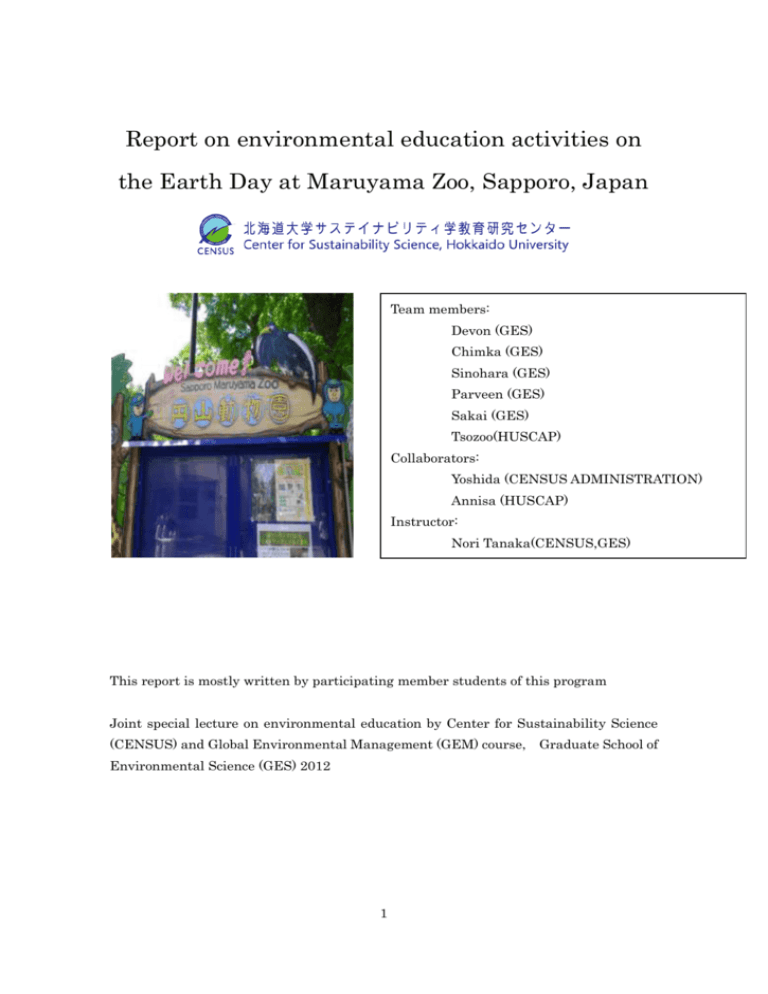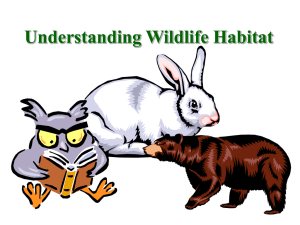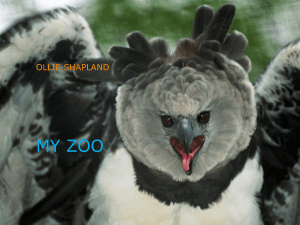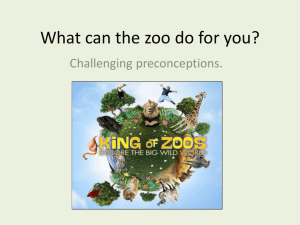Prologue(Devon)
advertisement

Report on environmental education activities on the Earth Day at Maruyama Zoo, Sapporo, Japan Team members: Devon (GES) Chimka (GES) Sinohara (GES) Parveen (GES) Sakai (GES) Tsozoo(HUSCAP) Collaborators: Yoshida (CENSUS ADMINISTRATION) Annisa (HUSCAP) Instructor: Nori Tanaka(CENSUS,GES) This report is mostly written by participating member students of this program Joint special lecture on environmental education by Center for Sustainability Science (CENSUS) and Global Environmental Management (GEM) course, Graduate School of Environmental Science (GES) 2012 1 Table of contents – Prologue(Doven) – General introduction( Nori) – Objective of the education program of Maruyama Zoo for the Earth day event(Parveen, Chimka, Tsozoo) – Activities • Under 8(Devon) • Over 8(Parveen) • General (Treasure hunting, Presentations, Awarding price )(Chimka, Sino,Nori) – Evaluation(Questionnaire, suggestion from participants on the site)(Sino, Nori) – Closing remarks( Nori) 2 Prologue(Devon) The young mind is an important mind since it can be molded and shaped to accomplish great and desirable things in the future. The world is faced with global challenges such as climate change, habitat destruction, widespread pollution, new and emerging diseases and the list goes on. As irresponsible inhabitants who have contributed in no small way to the degradation of the planet we call home it this therefore imperative that we attempt to curb our bad practices, reverse the damaging effects on the globe and try to preserve our children’s future. Unfortunately, this will not happen in our lifetime although we are the ones to begin the process and therefore we have to continue the cycle so that our children and their children will maintain this legacy. Therefore, recognizing this fact, we embarked on a project aimed at educating young minds who may be able to influence an untold number of persons in the life they are yet to live. The repercussions of any seemingly small action must never be underestimated. This content of this report reveals what a group of young people can accomplish if they work together with the common objective of making the world and its fauna and flora more sustainable. It is also hoped that the contents of this report will motivate others to follow in our footsteps, duplicate and further enhance the activities embarked on Earth Day 2012 at the Maruyama Zoo in Sapporo, Hokkaido. Let’s continue to educate our children and work together to save planet earth. 3 General Introduction (Nori) The root of a kind of formal environmental education could go back to 19th century in the United States of America. Mr. Theodore Roosevelt, 26th President of United States of America, who was known as an active naturalist at the time, established "The American Committee for International Wild Life Protection" in 1930. This committee has later become "The International Union for Conservation of Nature and Natural Resources" in 1948. The inauguration speech of this international union is known at the first time to introduce the term of "Environmental Education". In the early stages of environmental education, nature study, outdoor education and conservation education are major activities in the education. The objective of nature study, outdoor education and conservation education is mainly to let people know better about nature and raise awareness of importance of nature. In 1960s, environmental pollution and the related disease became serious problems in United states, European countries and Japan. Consequently, environmental education has been taken very seriously by governments, resulting that environmental education is in part of curriculum in compulsory education. Naturally, more focus put to prevention of air, water, soil pollutions and conservation of natural ecosystems. Achieving such effective environmental educations, well trained teachers are needed. However, at least in Japan, there is no teachers in compulsory education, who are specially trained how to conduct environmental education because there is not such a curriculum subject in elementary and junior high schools yet. In fact, last 20 years or so in Japan, many NPOs have been major players in children and adult environmental educations outside formal education systems. More recently, global environmental problem such as global warming due to CO2 and other greenhouse gases emission to the atmosphere is placed at the front of environmental issues. Therefore, environmental experts are now forced to consider both global and local aspects to seek individual solutions. " Think globally! Act locally! " is widely used phrase now. Even new term as "Glocal" is introduced. Indeed, spacio-temporal aspects are essential perspectives for new leaders in environmental researchers and practitioners in these days. The most part of this report is written by students as a part of course work for fostering practitioners for environmental education in the course of Global Environmental Management (GEM), Graduate School of Environmental Science, Hokkaido University. 4 The GEM course aims to raise international experts to work for environmental education and research under multi-disciplinary supervision. This training course is designed to provide hands on experiences in environmental education in the GEM. Our class team designed and conducted children and family activities in Maruyama Zoo, taking a special opportunity of the Zoo for the Earth day event on June 2-3, 2012. In this report, we provide details of our activities in planning, execution, evaluation and debriefing, which is a kind of PDCA (Plan-Do-Check-Act) cycle. Hope that this report provide valuable information to fresh men and women in the future class. 5 Objective of the education program of Maruyama Zoo for the Earth day event (Parveen, Chimka, Tsozoo) General objective To raise the awareness of kids and their parents on various aspects of wildlife Specific objectives To teach kids to recognize difference between wild and domestic animals by using pets and not pets cards, and color game To create awareness about threatened animals and their feeds, habitat, human usage, and threats by using animal puzzle game To challenge the participants to learn and find out new information related to animals of the Maruyama zoo by treasure hunt game To encourage learning about some crucial issues of wildlife that they are facing at the moment by power point presentation and discussion Activities 1) Color activity for children with age under 8 (Devon) Introduction Differences between wild and domesticated animals are important. Wildlife is an animal that lives in its natural state, providing for its own food, shelter and other needs in a suitable habitat. Domestic animals are those that humans keep in captivity or are bred for a specific purpose. Wild animals can become pets if they are properly tamed and domesticated but the difference between them and dogs and cats for example is that although they may 6 appear tame, they may still be wild. Another aspect to note is that although wild animals may be tamed and domesticated they are usually unsuitable as pets and in most cases are illegal to keep as pets. Many animals are native to a particular region or area and are therefore well adapted to that particular environment and habitat. It is important to identify animals that are native because invasive species are problematic since they can affect the native species by dominating them and making them extinct or endangered. Children must know that even though an animal is seen in a zoo that may have come from another country or region that does not mean that the animal exists in their region. The existence of an animal in a particular area refers to their presence in the natural environment. Objective Children can recognize differences between wildlife and domestic animals. Children can determine which animals should be kept as pets as against those that are better left in the wild. Children will realize that animals exist in a wide variety in the wild using colors as one of the characteristics. Materials used Pictures of brightly colored animals. Colored cardboard. Question cards. Instructions First the child selects an animal of his/her preference. The child then identifies its color. Next he/she determines whether or not it can or should be kept as a pet. The child then determines whether or not the animal can be found in the region in which they live. (Hokkaido) 7 Participants A total of 20 children participated in the activity with 60% being girls and 40% being boys. A total of 80% of the participants were accompanied by their parents. The age range was between 4 and 22 with the participants over 12 participating in English thus having a chance to practice communication in that language. Observations and Feed back The participants were very responsive to the activity and the encouragement and communication skills of the facilitators were very essential in the success of its operation. Some examples of additional questions that were required to prompt the correct answers from were for example: “Which one is your favorite animal?” (Asked whenever there is a delay in choosing the animal) “What other color can you see?” (Asked when they mention a color that is on the card but is not the dominant color of the animal) Have you ever seen this animal in your neighborhood? (Asked when they are unsure if the animal is in Sapporo or not) “Can you live with this animal?” “Do you think your parents would love living with this animal in the house?” (Asked whenever they are unsure if the animal is suitable as a pet) Parents who accompanied the children seemed very enthusiastic as their children were seen responding correctly to the questions. They also facilitated the exercise at times for example: A boy chose a poisonous green tree frog and he said that he can have it as a pet. His mother then said that she cannot live with it and he changed his mind and said he cannot have it as pet anymore. 8 Participants were generally very intelligent and brave and made analysis that we did not anticipate. For example: A girl chose a pigeon like bird that is not native to Japan. She said that she can have it as a pet but it is not possible to have it because she never saw it in Japan. In cases were siblings and friends came together, it was noted that they helped each other, gave differing opinions on a question and that made it even more interesting. A case to note is the following: Two boys came together and one of them chose a yellow butterfly. One of them said it is in Hokkaido. The other boy told him he never saw that butterfly in Sapporo and they discussed among themselves and he eventually changed his mind and said it is not in Sapporo. It was very heartening to have a special needs participant who was in a wheel chair accompanied by her mother and sister and to see them go through the activity together. She chose the yellow frog. Initially the activity was perceived as one to be done in groups but in practice it was conducted on an individual basis. This was positive because it allowed for each participant to answer every question and the time to go through the complete exercise was roughly about 2-3 minutes and therefore not time consuming for persons who may want to move on to other things. In addition, it allowed for children to choose their pictures without any competition whatsoever. It was pointed out by one of the parents that it would have been nice to have information on the animals pictured at the back so that the souvenir picture would also be informative. This will be done if and when it is repeated. Conclusions It can be concluded that the activity was conducted successfully and fulfilled the desired objectives and it is hoped that the participants are somehow motivated to learn more about animals and their welfare and sustainability. 9 2) Animal puzzle game for children with age over 8 (Parveen、Febrina) Introduction An ecosystem is an ecological system formed by the inherent interrelationship between living things and their environment. Ecosystem can also be said as an order of whole and complete unity among all the environmental elements that affect each other. In ecosystems, organisms evolve in a community together with the physical environment as a system. The organism will adapt to the physical environment, whereas organisms also affect the physical environment for living purposes. Human beings have a very important role in maintaining the balance and sustainability of ecosystems. This concept should be learnt and realized from early age. Since human beings have very initial roles in maintaining the sustainability of ecosystems, then the environmental education can be early taught to children through the simple and familiar ways that they easily understand, such as by introducing them the kinds of organisms, for instance animals. Why should we choose animals? Because they can more easily learn things that they are familiar with. Even when they were toddlers, they were already introduced to several animals both pets and wild animals. Therefore, animals are not alien things for them. Every human being on the earth has responsibility to conserve threatened wildlife, so children should also know about them. Environmentally aware people can play an active role in conservation of wild animals, and this will help to reduce the extinction rate of wild animals. These days children have a less idea about the wildlife, especially related to threatened animals. Indeed they are more interested in video games and cartoons in televisions. Most of them are seeing animals in zoos, and has no idea about their natural habitat, and associated threats in the wild. So introduced or make them aware about wild animal’s habitats, feeds, human usage, and survival threats are necessary, and should be the part of environmental education program in school. Therefore, this activity is designed for kids older than 8 years to introduce them about the threatened animals from around the globe. This activity will cover eight threatened wild animals viz. Snow Leopard, Blue-fin Tuna, Red Crowned Crane, Sea Turtle, Honey Bees, Polar Bear, Hornbill, and Musk Dear. Objectives To create children's awareness about threatened wild animals 10 To introduce children about the feeds of threatened wild animals To introduce children about the habitats of threatened wild animals To introduce children about the human usages of threatened wild animals To introduce children about the threats of threatened wild animals Materials used Pictures of threatened animals, their feeds, habitats, human uses, and threats. White boards Magnets Markers Pictures of wild animals as posters for souvenirs Instructions 1. Eight threatened animals were selected on the basis of their conservation status and habitat types. 2. Pictures associated with their main feed, habitat, human usage, and associate threats were collected and printed. 3. Magnet strips were attached to each picture to facilitate adhesion to the white board. 4. Pictures were equally distributed in two white boards and one animal was assigned as the example. Other pictures were randomly placed in the white board. 5. Instructors provided the direct information related to animals in details to facilitate the game. 6. One the basis of example set and instructions kids were asked to arrange pictures in proper order. After the rearrangement in correct orders, kids have been given detail information by the instructors related to wild animals and their feeds, natural habitats, human usages, and main environmental threats to them. 7. More information related to wild animals and threats associated with them were discussed with participants. After the completion of activity kids were awarded with the poster of a wild animal as a souvenir. Outcome of the activity More than 20 kids enthusiastically participated in the activity mostly 11 accompanied by their parents. Some kids also came with their friends and classmates. Most of them worked as a team to crack downed the animal puzzle game. Whenever they felt any difficulty in matching threatened animals with their feeds or habitats instructors provided hint about the wild animals. For an instance a child was facing difficulty in matching habitat of Musk Deer, then instructor hinted about high mountains, and the child instantly recognized the habitat. With provided hint others kids were also able to rearrange the pictures in right order. It was noted that kids and their parents have knowledge about most common and famous threatened animals such as snow leopard, polar bear, and blue fin tuna. However, they have less idea about not so common animals such as musk deer and hornbill. It was also observed that kids possessed significant knowledge about the animals, which are present in the Maruyama zoo such as snow leopard, and polar bear. It is desired that kids have learned about threatened animals, and this activity has facilitated to increase their awareness level. Sidewise, parents also got chance to know about the knowledge level of their kids focusing on wild animals. On the basis of kids performance on the activity, parents can encourage them to learn more about important expect of wildlife in our lives. Thus in can be concluded that this type of activity and interaction have motivated kids to know more about threatened wild animals and their feeds, habitats, human usages, and threats. Future directions Following things should be considered in future while carrying this type of activity: 1. Selection of wild animals should be diverse including indigenous threatened animals 2. Fact sheet about each animal should be prepared and provided to the participants after the activity 3. Videos related to animals should be shown sidewise to provide more information 3)General Activities (Treasure hunting, Presentations, Awarding price ) 3-1 Treasure Hunting(Chimka) Treasure hunt (Quiz) 12 Introduction Due to climate change and anthropogenic factors that influence its projection, the world we are living in is continuously changing. Some places and ecosystems are more vulnerable to the occuring, the same as to some species and their habitats. Human kinds have been a part of the natural system. For the last few centuries it became the dominant species. Though we can enjoy all the advantages of modern life, human activities are causing destruction to the wild life and deterioration of their natural environment. To sustain our modern comfortable lifestyle, we need to consider about the environment for it is the origin of our existence. Education is a powerful tool in order to change the mindset of general public. Especially kids are curious and adaptive to new discoveries; though kids these days especially from urban areas have less interaction with wild nature and wildlife therefore are not aware of the issues and problems that occur. Zoo is another place where kids can have quality time with their friends and families observing and making some small discoveries about our world. It is also a great place to learn about wildlife Objectives To raise the awareness of kids and their parents on specific aspects of wildlife and animals Educational quiz that challenges the participants to learn and find out new information and have different perspective on some crucial issues that are facing at the moment 13 Materials used Brochure with the general information Quiz questions 14 Treasure Hunt (Quiz) questions 1. What is the major threat of the habitat for polar bears? ___________________________________ 2. Find three kinds of monkeys in the zoo and point out what is the characteristic difference for each monkey. 1)_________________________2)_____________________________3)___________________ 3. This red animal lives in the moist sub-alpine forest from Southern China and northern Myanmar. It feeds on bamboo and mushrooms. What is it?______________________________________________ 4. Tell three animals that can do seasonal color change. 1)__________________________2)_____________________________3)__________________ 5. This big white animal lives in Arctic region and it is one of very popular animals in the Maruyama Zoo. What is it?_______________________________________________ 6. Suggest three animals in the zoo, classified as endangered in Japan. 1)_________________________2)_____________________________3)___________________ 7. Find scientific names for : 1)Buzzards _______________________________________________ 2)Fowls _______________________________________________ 3)White storks _______________________________________________ What is the similarity?______________________________________________ 8. Which is the most significant threat for wildlife? Please circle the correct answer. a) River pollution, b) Climate change, c) Deforestation 9. What is the best way to protect wild animals? _________________________________________ 10. Why diversity in nature is important? _______________________________________________ Instructions 1. Fill in the answers on the question sheet. (Most of the answers can be found on the information cards on the animal cages in the zoo) 2. Write down your name and contact information. 3. Bring and place in the campaign box before 14:00. 4. Come to the Zoo center at 15:00 for prize giving exercise. 15 Results of participants Reecived 17 answer sheets ◦ 15 points – 1 ◦ 14 points – 1 ◦ 13 points -2 ◦ 12 points -2 ◦ 11 points -4 ◦ 7 points – 2 ◦ 6 points – 4 ◦ 4 points -1 Answers to the Questions 1. Sea ice melting, global warming, climate change… - 1 2. Pictures of Monkeys attached - 3 3. Red Panda – 1 4. Reptiles, birds, deer, rabbit, wolf… - 3 5. Polar bear -1 6. Endangered animals in Japan – 3 7. 1)Buzzards __Buteo buteo 2) Fowls ______Gallus gallus 3) White storks ___Ciconia ciconia /Same species and genus names/ - 3 8. a) River pollution – 1 b) Climate change – 3 c) Deforestation – 2 9. a) practice proper waste disposal, b) slow down when an animal is on the road, c) recycle and reuse to limit the impact on natural resources, d) don’t use dangerous pesticides and chemicals, e) Control my pets when outdoors because they can kill wildlife, f) don’t buy products if not produced in a sustainable way, g) don’t buy products made from endangered animals - 1 10. Biodiversity boosts ecosystem productivity where each species, no matter how small, all have an important role to play - 1 16 /In total – 20 points/ Observations and Feed back 1st question 1. What is the major threat of… 2nd question 2. Find three kinds of monkeys in the zoo and point out what is the… 7 1 Right Right Wrong 10 16 3rd question 4th question 3. This red animal lives in the moist sub-alpine forest from Southern China and northern Myanmar. It feeds on… 3 4. Tell three animals that can do seasonal color change. 6 Right 14 6th question 5th question 0 7 6. Suggest three animals in the zoo, classified as endangered in Japan.… Right 10 Right 17 Right 0 11 5. This big white animal lives in Arctic region and it is one of very popular animals in the Maruyama… Wrong Wrong Wrong Partially right 17 7th question 7. Find scientific names for : 1)Buzzards 2)Fowls… 8th question 8. Which is the most significant threat for wildlife? 1 2 1st favorable 2nd favorable Right Wrong 14 3rd favorable 9th question 10th question 9. What is the best way to protect wild animals? 10. Why diversity in nature is important? Right Right Wrong Wrong Going around the zoo finding answers to various questions ranging from easy to medium levels. Questions that are considered difficult required the participants’ own opinions and thoughts. With the upper questions, we wanted kids and their parents to identify some animals by giving some descriptions, notice differences of animals within one classification, notice their scientific names, their knowledge on endangered animals, current threats to the wildlife and their habitats, and their own opinion on the importance of biodiversity and wild life protection. All the participants showed their effort and interest in the treasure hunt activity. Most of the kids were accompanied by their parents, so it was a great opportunity to grab their parents’ attention on the aforementioned problems. Kids were very impressive how much effort they put in trying to answer as many questions as possible. Especially at the end, 2 boys came and were trying to find answers on the importance of biodiversity from the books that were in Zoo Centre. Further Improvements Design of the brochure 18 ◦ To make it easy to find the instructions ◦ To make more easier to folding in shape Selection of the questions Accurate translation Evaluation (Nori, and Sino) We collected answer sheets and checked their scores. Based on the scores, we selected 10 top participants and giving them prize. Before the prize giving ceremony, Mr. Shinohara and Dr. Noriyuki Tanaka gave them lectures on endangered wide animals and provided them answers for the questions. Approximately 30 children and parents attended the prize giving ceremony session. we asked many question to children, which could be acquired during our activities in Maruyama zoo at the day. We found that children were very actively involved and learning further on wild animals in the zoo and elsewhere. Presentations: Presentations used for explaining the objectives of this activities as a whole and for showing desirable answers for the questions are shown in appendix 1. Presentation shows endangered species in Japan and the causes for the reduction of the number of species. The most widely recognized and quoted species is now in Japan is "Toki", Nipponia Nippon. In the presentation, details on "Toki" is presented and the efforts to put "Toki" back to our environment is shown. The gaining "Toki" habitat is not only to release "Toki" somewhere else is not far enough because proper feeding ground and "Satoyama" like landscape must be recovered. In the presentation, many local peoples like farmers, local governmental officers, officers of Ministry of Environment, many NPOs are clearly appreciated for the activities to regain "Toki" habitation in Noto peninsula, Japan. Many participants know about "Toki" but surprisingly, few knew that "Toki"' scientific name, which has Japanese country name in Japanese language. Questionnaire survey: After the zoo activity, we sent questionnaires to participating children and accompanied parents by mail to collect if the activities could affect the children's daily behavior or not. In order to increase the number of questionnaires, we put a stamped return envelop, retrieved answer sheet on the event and pictures taken by Tsozoo. We sent thirty four questionnaires. After a month, 7 questionnaires were received by mail, 19 which were 12% of the total participants and 21% of questionnaires sent by mail. This was much less reply we expected but there were useful comments from them. In the questionnaires, we asked following questions (Questionnaires sheet in Japanese is in Appendix 2). 1) Participated activities (color game, animal puzzle and treasure hunter) 2) After the event participation, what are specifically learned by children? 3) Is there any change in behavior of children in terms of environmental issues? 4) Is there any change in children's behavior? 5) Suggestions to improve future our activities Five color games and four animal puzzles among returned questionnaires were participating game activities. Only Two were answered to participate in treasure hunter game. Three were noticed some change in children mind more to care about nature and wild animals by asking related questions to the parents. One child showed clearly his appreciation to what you eat every day. Overall, the reply showed positive impression about our program. One strongly suggested that the content level of the program, especially last presentation about bio-diversity, should be more easily understandable. Therefore, materials for presentation may need to be improved further. Closing Remarks ( Nori) This report should be valuable documents to demonstrate the effectiveness of so called participating education scheme in university curriculum. The class members are both undergraduate and graduate students, who have various nationalities such as Japanese, Mongolian, Nepalese, Indonesian and Guyanese. In this class activities, the team with such diverse backgrounds in culture, tradition and professional disciplines demonstrated to work together toward common objectives of the project. Certainly, this is a cornerstone of class activities outside university campus and lessons learned by both participating students and instructors. Many participants in this zoo activities are very collaborative and seems enjoy learning about wild animals and the problematic relationship with human through provided games and lectures. We acknowledge Maruyama Zoo staffs, Mr. Toru Kikuta, Dr. Gakushi Ishimura and Ms. Yumiko Yoshida for providing such nice opportunity to the class to participating the Earth Day event and on-site support for the activities. 20 Appendix 1 Presentation materials 21 22 23 24 25 26 27 28 29 30 31 32 33 34 Appendix II アンケート調査へのお願い 先日の円山動物園アースデイでは本学の企画いべ b とにご参加いただき誠にありがとうご ざいました。 お手数をおかけいたしますが、本アンケートにお答えいただき、同封の編 使用の封筒に入れて返送していただければ幸甚です。 本企画の効果を確認させていただ いて、より良い企画を今後提供させていただくための参考にさせていただきます。 1)参加したイベントは何ですか? あ)色遊び い)アニマルパズル う)トレジャーハンター 2)この企画で野生動物について何を学ぶことができましたか? 3)この企画にご参加していただいたあとで、お子様と野生動物についてなにか話合われ たでしょうか? もし、話合われたのであれば、その内容をお聞かせください。 4)この企画にご参加していただいたあとで、野生動物のためにと、何か普段の生活の仕 方を変えましたか? もし、何か変えたのであれば、その内容をお聞かせください。 と くに、子供たちの変化につてお聞かせいただければ幸いです。 5)その他、この企画に関してお気づきの点や完全すべき点がありましたら是非お聞かせ ください。 35





